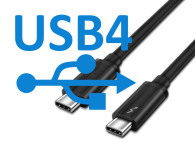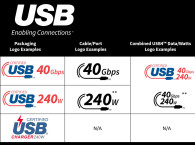Reminding those who have been hibernating, the USB-IF announced the publication of the latest and greatest USB4 specification in September 2019, offering a major update to the USB architecture that complements and builds upon the existing USB 3.2 and USB 2.0 architectures. But this next-generation USB specification is also much more than that!
As formerly discussed when the development initiative was revealed, in March 2019, the USB4 architecture is based on the Thunderbolt protocol specification contributed by Intel Corp. to the USB Promoter Group. This enables the USB4 solution to evolve to a two-lane operation using existing USB Type-C cables and delivering up to 40 Gbps operation over 40 Gbps certified cables, with multiple data and display protocols efficiently sharing the total available bus bandwidth. And of course, all devices based on USB4 will be backward compatible with USB 2.0, USB 3.2, and Thunderbolt 3.
At CES 2020 I met once again with Jeff Ravencraft, Rahman Ismail, and Brad Saunders, and learned that things are actually well consolidated, with the work toward USB4 implementation well underway and the USB-IF focusing on some of the most relevant aspects and application areas for the technology, which is the Certified USB Fast Charger and the adoption of USB Type-C by automotive companies.

About the USB Charging Initiative, we learned that Certified USB Fast Chargers are seeing strong industry adoption, and that's the reason why the USB-IF decided to expand its USB Charging Initiative to include Certified USB Fast Chargers. The certification program is supported with a multi-million dollar annual investment and by 16 certified independent test labs across the US, Europe, and Asia.
According to Jeff Ravencraft, the USB-IF President and COO, there was a clear surge in implementation of USB Fast Charging, with 181 certified solutions to date, and Certified USB Fast Chargers now supporting the Programmable Power Supply (PPS) function of the USB Power Delivery 3.0 specification. This requires new USB hosts, devices, and chargers supporting PPS for users to take full advantage, but the benefits are clear, allowing the smartphone OEMs to better manage the thermals while charging, enabling a faster (and safer) charging experience for consumers, while optimizing the batteries. This is so clearly beneficial for consumers, that I have no doubt it will be one of the leading reasons why we will see extremely fast adoption.

Regarding the automotive market, we've learned that the USB Type-C connectivity standard is seeing rapid adoption among mass-market models, with mainstream OEM applications starting with the 2018 models and rapidly proliferating among premium and mid-market vehicles. Still the USB-IF knows that USB Type-C will be complementary to USB Std-A in the near future, with USB-C eventually becoming the predominant form factor over the coming decade. The USB-IF estimates that meaningful volumes will start in 2020, doubling the number of car models shipping with USB-C, and reaching half of all vehicles in 2026. Audi, Mercedes, Cadillac, Ford, Jeep, GMC, Porsche, BMW, and Volvo are among the brands to ship all new 2020 models already equipped with USB-C ports.

The Big Audio Class Surprise
But the biggest news to come out of this CES USB-IF briefing - albeit still short on details - is the confirmation that there is actually advances work on USB Audio Device Class 4.0. Even though no official reference to this has been released so far, this is something we feel needs to be shared with the audioXpress audio developers and manufacturing community.
A new USB Audio Device Class 4.0 specification will finally reflect the ongoing work, basically since the release of the USB Audio Device Class 3.0 Specification in September of 2016 - and which has not progressed primarily because there were other pressing priorities. At that time, the 3.0 specification update focused on establishing USB Audio over USB Type-C for digital audio applications, efficiently delivering data, power and video over a single USB Type-C connector with USB Power Delivery. The updated specification also defined capabilities to reduce power consumption, and defined interoperability requirements across analog and digital solutions to minimize user confusion when not all hosts or devices consistently support audio. It was basically a "maintenance" update that made sense given the transition to the new connector and the new possibilities with USB Power Delivery.
Now, the upcoming USB Audio Device Class 4.0, will finally extend the interface capabilities including managing latency, dynamically changing data streams, changing number of incoming channels, data format, etc., handling sources that change format in real time, and introducing better support for DSD and High Resolution PCM formats.

The new specification also promises to pave the way for personalization, with support for a bank of digital filters, including enhanced user-defined equalizers, and will implement support for EN 50332 safe-listening levels.
Until the new specification is released, work is still ongoing and new features are being considered, which means that this is good time for audio companies to get actively involved and reach out to Rahman Ismail, who is leading the effort.
We couldn't help noticing how much more confident in the message the entire USB-IF team seemed to be, as compared with last year. The confidence in the simple USB4 message is something that the team believes will translate to the industry and eventually to consumers, helping to dilute the complicated transition for the standard as it stood last year.
"Eventually, it will all be about USB4," Brad Saunders confidently said during our sequence of questions. Yes, for consumers, sooner or later, people will simply recognize USB4, even if in reality the underlying technologies in the market will continue to be in the vast majority based on USB 2.0 and USB 3.2, and of course USB Power Delivery 3.0, which is the evolution that's propelling the technology forward, currently.

This means that USB4 will be a reality in the mainstream market for consumer electronics and the mobile industry starting in 2021. Of course, this should not significantly impact the professional audio industry, which is strongly committed with Thunderbolt 3, and can commit even more confidently, knowing that USB4 will simply expand support for current investments. But, that's a story for another article...
This article was published originally in The Audio Voice 264 newsletter, February 6, 2020.
Register here to receive The Audio Voice weekly: http://bit.ly/1ri0b4J







